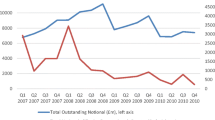Abstract
The purpose of this paper is to shed light on the history of commercial property values over the past decade, and to compare different methods of constructing commercial property value indices and returns series. We examine three types of indices: (i) Indices that attempt to reconstructproperty market values by “unsmoothing” the appraisal-based Russell-NCREIF Index; (ii) Indices that trace average ex posttransaction prices of commercial property over time; and (iii) an index based onunlevering REIT share prices. By comparing the different historical pictures that result from the various index construction methodologies, one gains insight into the nature of commercial property price and valuation behavior. The REIT-based values lead the other indices in time but display greater short-run volatility. The transactions-based indices lag behind the other series in time, and are consistent with the idea that institutional investors attempt to hold onto properties until they can sell them for a price at least equal to the current appraised value, in effect trading off liquidity for reduced volatility.
Similar content being viewed by others
References
Bailey, M., R. Muth, H. Nourse. (1963). “A Regression Method for Real Estate Price Index Construction,”Journal of the American Statistical Association 58: 933–942.
Black, F. (1985). “Noise,”Journal of Finance 40(3).
Blundell, G., C. Ward. (1987). “Property Portfolio Allocation: A Multi-Factor Model,”Land Development Studies 4:145–156.
Bryan, T. and P. Colwell. (1982). “Housing Price Indexes,”Research in Real Estate 2, 57–84.
Case, K., R. Shiller. (1989). “The Efficiency of the Market for Single Family Homes,”American Economic Review 79(1): 125–137.
Clapp, J., C. Giacotto. (1992). “Estimating Price Indices for Residential Property: A Comparison of Repeat Sales and Assessed Value Methods,”Journal of the American Statistical Association 87: 300–306.
Cole, R., D. Guilkey, and M. Miles. (1987). “Pension Fund Investment Managers Unit Values Deserve Confidence,”Real Estate Review 17(1) 84–89.
Court, A. (1939). “Hedonic Price Indexes with Automotive Examples,”The Dynamics of Automobile Demand. New York: General Motors Corporation, 99–117.
Fama, E.F., and G.W. Schwert. (1977). “Asset Returns and Inflation,”Journal of Financial Economics 5, 115–146.
Fama, E.F., and K.R. French. (1988a). “Permanent and Temporary Components of Stock Prices,”Journal of Political Economy 96, 246–273.
Geltner, D. (1989). “Estimating Real Estate's Systematic Risk from Aggregate Level Appraisal-Based Returns,”AREUEA Journal 17(4) 463–481.
Geltner, D. (1991). “Smoothing in Appraisal-Based Returns,”Journal of Real Estate Finance and Economics 4(3), 327–345.
Geltner, D. (1993a). “Temporal Aggregation in Real Estate Return Indices”AREUEA Journal 21(2).
Geltner, D. (1993b). “Estimating Market Values from Appraised Values Without Assuming an Efficient Market,”Journal of Real Estate Research 8(3).
Goetzmann, W. and Ibbotson. (1990). “The Performance of Real Estate as an Asset Class,”Journal of Applied Corporate Finance 3(1) 65–76.
Griliches, Z. and I. Adelman. (1961). “On an Index of Quality Change,”Journal of the American Statistical Association 535–548.
Gyourko, J., D. Keim. (1992). “What Does the Stock Market Tell Us About Real Estate Returns,”AREUEA Journal 20(3): 457–486.
Hoag, J.W. (1980). “Toward Indices of Real Estate Value and Return,”Journal of Finance, May.
Liu, C., D. Hartzell, T. Grissom, W. Greig. (1990a). “The Composition of the Market Portfolio and Real Estate Investment Performance,”AREUEA Journal 18(1): 49–75.
Liu, C., D. Hartzell, T. Grissom, W. Greig. (1990b). “The Integration of the Real Estate Market and the Stock Market: Some Preliminary Evidence,”Journal of Real Estate Finance and Economics 3(3): 262–282.
Lee, C., A. Scheifer, and R. Thaler. (1991). “Noise Trading and the Clsoed-End Mutual Fund Puzzle,”Journal of Finance 46(1), 75–109.
Miles, M. (1989a). “Real Estae as an Asset Class: A 25 year Perspective,”Salomon Brothers Bond Market Research, January.
Miles, M., R. Cole, and D. Guilkey. (1990). “A Different Look at Commercial Real Estate Returns,”AREUEA Journal, Winter.
Miles, M., D. Guilkey, B. Webb, and K. Hunter. (1993). “An Empirical Evaluation of the Reliability of Commercial Appraisals, 1978–1992,”NCREIF Research Paper.
Pollkowski, H. (1967). “Owner-Occupied Housing Price Change in the U.S., 1974–83: A Disaggregated Approach,” Report of the Harvard-MIT Joint Center for Housing Studies, August.
Quan, D. and J. Quigley. (1989). “Inferring an Investment Return Series for Real Estate from Observations on Sales,”AREUEA Journal 17(2) 218–230, Summer.
Quan, D. and J. Quigley. (1991). “Price Formation and the Appraisal Function in Real Estate,”Journal of Real Estate Finance and Economics 4(2) 127–146, June.
Ross, S. and R. Zisler. (1987). “Managing Real Estate Portfolios, Part 3: A Close Look at Equity Real Estate Risk,”Real Estate Research, Goldman Sachs, November.
Ross, S. and R. Zisler. (1991). “Risk and Return in Real Estate,”Journal of Real Estate Finance and Economics 4(2), 175–190, June.
Salomon Brothers. (1992). “Real Estate Risk and Return: 1991 Survey Results,” March 31.
Shiller, R. (1981). “Do Stock Prices Move Too Much to be Justified by Subsequent Changes in Dividends?”American Economic Review 71, 421–435.
Sirmans, G.S., and C.F. Sirmans. (1987). “The Historical Perspective of Real Estate Returns,”Journal of Portfolio Management, Spring.
Webb, B., M. Miles, and D. Guilkey. (1992). “Transactions-Driven Commercial Real Estae Returns: The Panacea to Asset Allocation Models?”AREUEA Journal 20(2): 325–357, Summer.
Wheaton, W. (1987). “The Cyclic Behavior of the National Office Market,”AREUEA Journal 15(4) 281–299, Winter.
Zerbst, R. and B. Cambon. (1984). “Historical Returns on Real Estate Investment,”Journal of Portfolio Management, Spring.
Author information
Authors and Affiliations
Rights and permissions
About this article
Cite this article
Fisher, J.D., Geltner, D.M. & Webb, R.B. Value indices of commercial real estate: A comparison of index construction methods. J Real Estate Finan Econ 9, 137–164 (1994). https://doi.org/10.1007/BF01099972
Issue Date:
DOI: https://doi.org/10.1007/BF01099972




